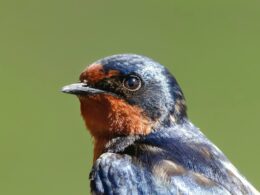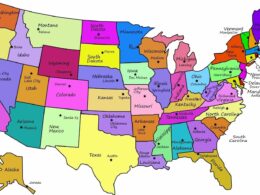Last Updated on January 9, 2024 by Greg Gillson
I’ve put this resource together for you to answer your question: What birds are in my backyard in Iowa?
This article lists and discusses the identification of the most common birds in your backyard. The birds chosen in this article are compiled from actual data from the citizen science program eBird. Thus, it is more accurate than some other similar articles you may find on the web. I provide pictures of each bird species mentioned and I’ll tell how to attract them to your backyard.
These are the most common backyard birds in Iowa:
- Northern Cardinal
- American Robin
- Black-capped Chickadee
- Blue Jay
- Downy Woodpecker
- American Crow
- American Goldfinch
- Red-bellied Woodpecker
- Red-winged Blackbird
- White-breasted Nuthatch
- House Sparrow
- Mourning Dove
- European Starling
- Dark-eyed Junco
- Song Sparrow
- House Finch
- Gray Catbird
- House Wren
- Common Grackle
- Northern Flicker
- Barn Swallow
- Indigo Bunting
- Brown-headed Cowbird
- Chipping Sparrow
- Eastern Kingbird
- Baltimore Oriole
- Eastern Wood-Pewee
Iowa Birds and Birding in Iowa State
eBird lists over 425 types of birds as occurring in the state of Iowa.
The most common bird in Iowa: the most frequently seen bird in the state is Northern Cardinal. It is reported on 49% of bird watching lists.
If you are serious about knowing the birds native to Iowa, then check out eBird for Iowa. It has recent sightings and photos, illustrated checklists with weekly abundance bar charts for state, counties, and individual hotspots of the best birding locations.
If you want to know about other people interested in birds in your area, join a local bird group. The American Birding Association maintains a list of bird watching clubs for each state.
Iowa Bird Identification
This section is the species accounts. These are designed to help you to recognize birds you see in your backyard. I have used eBird to select the birds that are most common. “Common” means the birds seen most often throughout the year, not necessarily the most numerous.
Each species account starts with a photograph. In the identification section I am using size and shape and bill type before considering the color or patterns on the birds. I find these more reliable when trying to identify an unknown bird. Pay attention to body and tail shape and especially bill shape of birds you see, not just plumage color.
In the section on bird feeders and foods I tell how to attract each species. Not all types of backyard birds will come to feeders. But all backyard birds can be attracted with water. So don’t forget to add a birdbath to your bird feeding station.
Do you live in Eastern Iowa? Central Iowa? Northwest Iowa? Northeast Iowa? Southeast Iowa?
To appear in this article, most birds are widely distributed throughout the state and are often year-round residents. However, for those birds that are more localized in place or time, I list the general region and seasonality. Please see the section following these species accounts for the lists of common species by season.
Even if a species is found in a general area, they occur only in the habitat they prefer. So, the exact habitat of your neighborhood is important for the presence of absence of certain kinds of birds.
1. Northern Cardinal (Cardinalis cardinalis)
This is one of the most common and popular backyard birds in the eastern half of the United States.
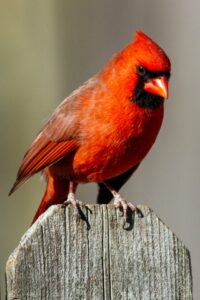
Range in Iowa: Northern Cardinals are year-round residents throughout Iowa.
Identification:
Size: Cardinals are a bit smaller than American Robins, about the same size as Red-winged Blackbirds.
Shape: Plump body with fairly long full tail. Wispy crest.
Bill: Short, heavy, conical, pink.
Color: That bright red color is matched by few other birds. Black face. The female is grayer, but with hints of red in wings and tail, and has a crest, too.
Habitat, range & behavior: Cardinals are year-round residents in shrubby woodland edges.
Found from the eastern United States to Texas and Arizona south into Mexico.
That large conical bill is made for chewing seeds. Watch them crack open sunflower seeds, spit out the hulls, and pluck the kernel with their tongues!
Food and feeder preference: Black oil sunflower seeds. Many types of seeds, berries, nuts in larger hopper or tray feeders.
You may like my in-depth article on attracting Northern Cardinals.
2. American Robin (Turdus migratorius)
This familiar bird is a resident in the northern half of the United States and a winter visitor in the southern half.
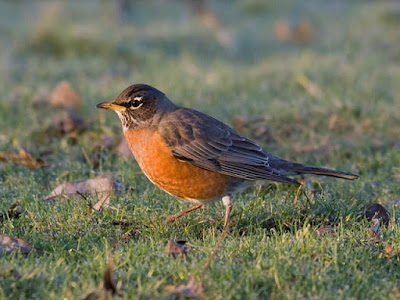 |
| American Robin. Greg Gillson |
Range in Iowa: American Robins are year-round residents throughout Iowa.
Identification: This is a key species for comparing with an unknown bird.
Size: 10 inches long from bill tip to tail tip. About the same size as a Blue Jay or one of the Scrub-Jays. Larger than Red-winged Blackbird. Smaller than a Mourning Dove.
Shape: Very plump with a fairly long tail.
Bill: Straight and fairly slender, curved at the tip.
Color: Gray-brown upperparts, rusty orange breast.
Habitat, range & behavior: Open woodlands, farmlands, urban parks and lawns.
Migratory, breeds north across Alaska and Canada. Resident in most of the United States (lower 48). Winters in the United States, Mexico, to central America.
Hops on your lawn turning head this way and that looking for food. Their caroling song is one of the early signs of spring in the north.
Food and feeder preference: Worms and other invertebrates in the lawn. May eat fruit from a tray feeder or the ground. Eat small berries from trees and bushes.
3. Black-capped Chickadee (Poecile atricapillus)
This is a common backyard bird in the northern half of the United States.
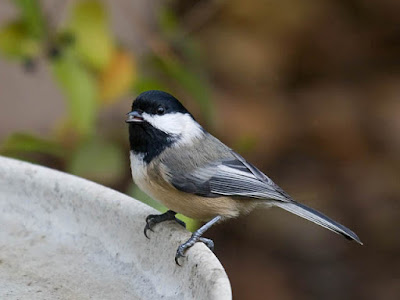 |
| Black-capped Chickadee. Greg Gillson |
Range in Iowa: Black-capped Chickadees are year-round residents throughout Iowa.
Identification:
Size: Chickadees are small birds, the same general size as an American Goldfinch.
Shape: Round body, big round head, long tail with rounded tip.
Bill: Short, straight, stout.
Color: Gray above, buffy below. Black cap and bib with white lower face. White edges on wing feathers.
Habitat, range & behavior: Deciduous and mixed forests.
They range from the northern half of the United States, southern half of Canada, and most of Alaska.
Small flocks flit actively from tree to tree acrobatically gleaning insects from twig tips. In winter chickadees make up the core of mixed-species flocks also containing nuthatches, kinglets, creepers, woodpeckers and others.
Food and feeder preference: Seeds, insects, berries. They eat at tube, hopper and tray feeders. They love black oil sunflower seeds and suet.
You may like my in-depth article on attracting Black-capped Chickadees.
4. Blue Jay (Cyanocitta cristata)
A common and well-known bird in the eastern half of the United States.
 |
| Blue Jay. skeeze. Pixabay |
Range in Iowa: Blue Jays are year-round residents throughout Iowa.
Identification:
Size: About that of American Robin.
Shape: Fluffy, large crested head, ample tail. Large strong legs.
Bill: Black, long and stout.
Color: Blue above, white below. Black neck collar. White patches in wing.
Habitat, range & behavior: Woodlands and towns.
Found in the eastern half of the United States. In summer into southern Canada.
Bold and brash. May bully smaller birds. Jays gulp lots of seeds or other food at once, storing it in their crop. Then they fly off and bury food items in a hidden cache.
Food and feeder preference: Omnivorous. They can quickly empty your feeder! Because they are also aggressive toward other feeder birds, some people put mesh cages around smaller bird feeders. Small birds can go through, squirrels and larger “pest” birds are prevented entry. Some people feed jays peanuts, perhaps away from the seed feeders.
5. Downy Woodpecker (Dryobates pubescens)
These tiny woodpeckers are found in backyards across the United States.
 |
| Downy Woodpecker. Greg Gillson |
Range in Iowa: Downy Woodpeckers are year-round residents throughout Iowa.
Identification:
Size: Bigger than a junco or House Finch. Smaller than a Red-winged Blackbird. About the same size as a White-crowned Sparrow, but with a much shorter tail.
Shape: Stocky with large head and short stiff tail.
Bill: Short, chisel shaped.
Color: Black-and-white striped head. Black wings with white spots. Solid white back. White under parts. Black tail with white outer tail feathers with black bars or spots. Male with small red spot at back of head.
Habitat, range & behavior: Found in small deciduous trees, willows, and even weed stocks such as teasel, especially near water.
Ranges coast-to-coast across all but northernmost parts of Canada and Alaska south to the southern US. Absent in the desert southwest.
Interestingly, I learned today that the males may more often be found in smaller plants and twigs, while females are more likely on tree trunks.
Food and feeder preference: Insects, fruits, and seeds. Gleans arthropods from the bark of trees. Attract with suet feeder. Will also eat black oil sunflower seeds.
6. American Crow (Corvus brachyrhynchos)
This larger all-black bird is common in cities and country. Its cawing call is familiar to most people.
 |
| American Crow. Greg Gillson |
Range in Iowa: American Crows are year-round residents throughout Iowa.
Identification: This is a key species for comparing with an unknown bird.
Size: About 17-1/2 inches long from bill tip to tail tip, though there is much size variation throughout its range. Larger than blackbirds and grackles. Smaller than ravens.
Shape: Thick neck, large head, rather short square-ended tail. Longer legs. In flight has rounded wing tips with each primary feather separated from others forming “fingers.”
Bill: As long as head, thick, black.
Color: Glossy black throughout.
Habitat, range & behavior: They prefer open areas with trees, fields, farms, cities.
They are common across most of the United States lower-48, except in the desert southwest. They move into southern Canada in summer.
They gather in evening communal roosts in large flocks that may number into the thousands and then move out at dawn into the surrounding area.
Food and feeder preference: Omnivorous, they feed on large insects, grain, small mammals, carrion. You probably don’t want these large entirely-black birds in your backyard feeders. So don’t feed table scraps to birds.
7. American Goldfinch (Spinus tristis)
A beautiful tiny finch familiar to many in it’s bright yellow summer plumage. Colloquially called a “wild canary.”
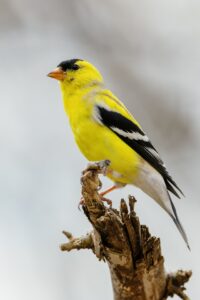
Range in Iowa: American Goldfinches are year-round residents throughout Iowa.
Identification: This is a key species for comparing with an unknown bird.
Size: Very small at about 5 inches from bill tip to tail tip. Similar in size to a chickadee. Larger than hummingbirds. Smaller than juncos and House Finches.
Shape: Tiny, somewhat plump with larger head and short tail.
Bill: Short, conical, pink.
Color: Males in summer are bright lemon yellow with black forehead and black wings and tail with white bars. White under tail coverts. Females are dull olive, wings and tail browner. Winter birds are pale grayish-yellow with tan and brown wings and tail.
Habitat, range & behavior: This species is found in weedy fields and similar clearings with thistles and similar plants.
It is found coast-to-coast throughout the year across most of the middle lower-48 states. In summer moves north to the Canada border. In the winter found south to the Mexico border.
The flight is highly undulating, rising and falling as they flap in short bursts. Besides a long, sweet lilting song, they call in flight a lilting 4-part: “potato chip!”
Food and feeder preference: Feeds on weed seeds, thistle seed. May eat black oil sunflower seeds from tube feeder. Love Nyjer seed in a feeder called a “thistle sock.”
You may like my in-depth article on attracting American Goldfinches.
8. Red-bellied Woodpecker (Melanerpes carolinus)
This is one of the most common species in the eastern half of the United States.
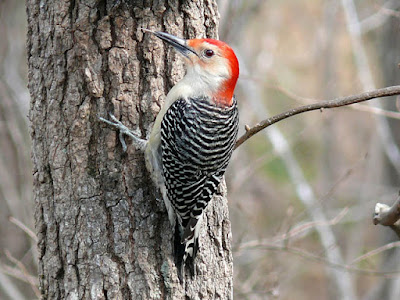 |
| Red-bellied Woodpecker. skeeze. Pixabay |
Range in Iowa: Red-bellied Woodpeckers are year-round residents throughout Iowa.
Identification:
Size: Fairly large for a backyard bird. Between a Starling and American Robin in size. Smaller than a Northern Flicker.
Shape: Stout with large head and short tail. Clings to tree trunk on strong short legs propped up with short stiff tail.
Bill: Long, chisel-shaped.
Color: Pale gray body, many thin black-and-white bars across back and wings. Red nape, extending forward on crown on male.
Habitat, range & behavior: These birds are found in many woodland types, including oak, hickory and pine.
They are found from the eastern slope of the Rocky Mountains in the lower-48 states from Texas to extreme southern Canada, and eastward from Florida northward just to the southern edge of the New England states.
In typical woodpecker fashion, it hitches up the tree trunk and larger branches.
Food and feeder preference: This species eats insects and nuts. They may eat peanuts from a tray feeder and eat from a suet block.
9. Red-winged Blackbird (Agelaius phoeniceus)
These noisy flocking birds are most often found in marshes. But in winter they are found in backyards.
 |
| Male Red-winged Blackbird. Greg Gillson. |
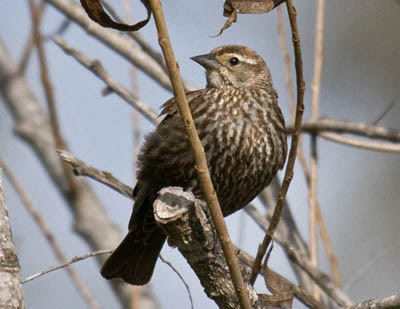 |
| Female Red-winged Blackbird. Greg Gillson. |
Range in Iowa: Red-winged Blackbirds are year-round residents throughout Iowa.
Identification: This is a key species for comparing with an unknown bird.
Size: About 8-3/4 inches long from bill tip to tail tip. About the size of a Northern Cardinal. Smaller than an American Robin.
Shape: Pot-bellied with a longer bill and flat forehead. Tail average.
Bill: Long and sharp pointed.
Color: Males are black with red and yellow shoulder patch. Females are streaked brown and rusty (sparrow-like but pointed bill and flat forehead).
Habitat, range, and behavior: Cattail marshes and wetlands are their summer habitat. In winter they feed in grain fields.
They breed across most of the North American continent. In winter they withdraw from most of Alaska and Canada.
They are found in colonies in summer and large flocks in winter.
Food and feeder preference: They eat insects in summer. In winter they eat grain and seeds. They visit feeders, more often in large winter flocks, and eat most seeds and suet.
10. White-breasted Nuthatch (Sitta carolinensis)
A favorite feeder bird for many for its active antics and fearlessness. Though a small bird it is the largest nuthatch in North America.
 |
| White-breasted Nuthatch. Greg Gillson |
Range in Iowa: White-breasted Nuthatches are year-round residents throughout Iowa.
Identification:
Size: About chickadee-sized in length. Smaller than a junco or House Finch.
Shape: Appears large-headed, neckless, very short tailed. Short legs.
Bill: Nearly as long as head, straight, thin.
Color: Blue-gray above, white below. Black cap, wing tips, tail. Rusty feathers under tail.
Habitat, range & behavior: Common in oak and oak-pine woodlands, wooded towns.
Found across the United States, southern Canada, mountains of central Mexico. Absent from treeless grasslands, deserts in the west.
Crawls over tree branches and head-first down tree trunks searching for insects.
Food and feeder preference: Insects, seeds, acorns and other nuts. Love black oil sunflower seeds feeding on hopper and tray feeders. Suet blocks.
11. House Sparrow (Passer domesticus)
Like the starling, this is another bird introduced from Europe in the 1800’s. This sparrow is commonly found in cities and farmlands. It is considered a pest in most areas where it has been introduced.
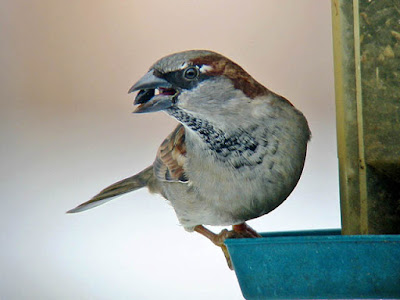 |
| House Sparrow. Greg Gillson |
Range in Iowa: House Sparrows are year-round residents throughout Iowa.
Identification:
Size: The size of a House Finch or Dark-eyed Junco.
Shape: Chunkier than native North American sparrows with large head, barrel chest, short neck, medium tail, short legs.
Bill: Short, conical.
Color: Males are brown and gray with a black mask. Females lack the black and are tan and brown with a pale line back from the eye.
Habitat, range & behavior: Cities and farms.
Range in North American from southern Canada through Central America. In summer northward through Canada to southern Alaska. Originated in Middle East and spread to most of Europe and Asia. Introduced in South America, Africa, Australia–nearly anywhere there are people and cities.
They tend to be messy… and have a good appetite and may occur in large noisy chirping flocks. They are aggressive toward other feeder birds.
Food and feeder preference: They eat grain, seed, and insects. To discourage them from your hopper and tray feeders do not feed birds human food scraps. They have a bit of difficulty eating from tube feeders.
12. Mourning Dove (Zenaida macroura)
Mourning Doves are the most widespread and most frequent backyard bird in the Lower 48 states of the United States.
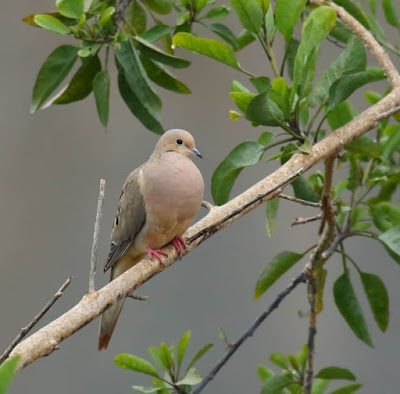 |
| Mourning Dove. Greg Gillson |
Range in Iowa: Mourning Doves are year-round residents throughout Iowa.
Identification: This is a key species for comparing with an unknown bird.
Size: About 12 inches long from bill tip to tail tip. About same size as Northern Flicker. Larger than American Robin. Slightly smaller than domestic city pigeon.
Shape: Very plump with a small round head. Tail is long and pointed. Legs are short.
Bill: Small and rather slender.
Color: Pale brown-pink body, darker wings and tail. White edges on side of tail.
Habitat, range & behavior: Semi-open areas such as urban areas, farmlands, woods.
It is a resident across the lower-48 states and Mexico, with some movement out of northern areas in winter.
Often seen perched on wires, fences. Their mournful cooing is a familiar spring birdsong.
Food and feeder preference: Mourning Doves eat seeds almost exclusively. Attract with black oil sunflower seeds on a large sturdy tray feeder or on the ground.
13. European Starling (Sturnus vulgaris)
Introduced to North America in the late 1800’s, they crossed the continent, often to the detriment of native cavity-nesting birds. The prime example of an invasive species.
 |
| European Starling. Greg Gillson |
Range in Iowa: European Starlings are year-round residents throughout Iowa.
Identification: This is a key species for comparing with an unknown bird.
Size: 8-1/2 inches from bill tip to tail tip. About the size of a Red-winged Blackbird. Smaller than an American Robin. Larger than a White-crowned Sparrow or Spotted/Eastern towhee.
Shape: Stocky with large head, short square-ended tail. Longer legs.
Bill: As long as head. Sharp pointed. Yellow in spring, otherwise dark.
Color: They are grayish brown much of the year, with glossy iridescence and white spotting during the spring.
Habitat, range & behavior: Lowland birds that need trees large enough for nest cavities but plenty of open area for feeding. They are most abundant in urban and suburban areas where they find food and artificial nest cavities.
Resident from coast-to-coast from southern Canada to northern Mexico. In summer north across Canada and Alaska. Native range is Europe to Pakistan, north Africa.
Often viewed as a pest, starlings often bully other backyard birds, taking over bird feeders, and stealing nest cavities from smaller native birds. In winter they can form into flocks of tens of thousands.
Food and feeder preference: Primarily insects when available, often feeding on the ground. Discourage them from your backyard hopper and tray feeders by never feeding birds table scraps (including bread or meat). They have weak feet and do not perch well on tube feeders. A cage mesh around smaller hopper feeders may keep them out.
14. Dark-eyed Junco (Junco hyemalis)
Colloquially called “snowbirds,” they often arrive in backyards in winter from nearby mountain forests or more northern climes.
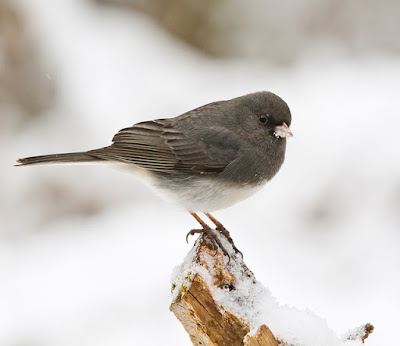 |
| Dark-eyed Junco. skeeze. Pixabay |
Range in Iowa: Dark-eyed Juncos are winter visitors throughout Iowa.
Identification:
Size: Small birds about the size of a House Finch.
Shape: Round body, short neck, round head, fairly long square-ended tail.
Bill: Short, pointed, conical, pink.
Color: Eastern birds are a darker all-gray with white belly. Western birds have jet black hood over head, brown back, and pink sides.
Habitat, range & behavior: Breed in coniferous forests. Winters widely. Avoids heavy brush, preferring widely spaced bushes.
Breeds across most of Canada, Alaska, and the western half of the United States. Winters from southern Canada and all of the lower 48-states to extreme northern Mexico.
Spend much of their time hopping and feeding on the ground.
Food and feeder preference: Eats mostly seeds, also insects in summer. Readily feed at backyard feeders on mixed seeds on hopper or tray feeders and ground.
You may like my in-depth article on attracting Dark-eyed Juncos.
15. Song Sparrow (Melospiza melodia)
A common bird, but variable, and similar to many other streaked brown sparrows.
 |
| Song Sparrow. Greg Gillson |
Range in Iowa: Song Sparrows are year-round residents throughout Iowa.
Identification:
Size: A smaller bird, similar in size to House Finch and juncos. Larger than chickadees and goldfinches. Smaller than White-crowned Sparrows or Spotted/Eastern towhees.
Shape: Plump with round head, long rounded tail.
Bill: Short, conical.
Color: Highly variable in darkness and color saturation across its range (dark rusty to pale gray). Generally gray-brown above with dark brown streaking on back. Complicated head pattern. Streaking on sides and breast converge into dense central breast spot.
Habitat, range & behavior: Thickets, especially near water. Backyard shrubbery.
Resident in western United States, western Canada, coastal southern Alaska, northeastern US. In summer also moves into mid-Canada and northern half of US. In the winter found in most of the US lower-48. Also a population in central Mexico.
Forages on ground, never far from low cover to which they fly if startled.
Food and feeder preference: They feed on seeds and insects near the ground. Will visit hopper and tray feeders for mixed bird seed.
16. House Finch (Haemorhous mexicanus)
These are one of the most common backyard birds in the United States. There are other red finches, but these are the ones most likely in residential areas.
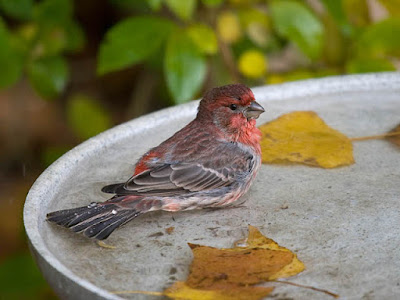 |
| House Finch. Greg Gillson. |
Range in Iowa: House Finches are year-round residents throughout Iowa.
Identification: This is a key species for comparing with an unknown bird.
Size: About 6 inches from bill tip to tail tip. Larger than goldfinches and chickadees. Smaller than a White-crowned Sparrows or Spotted/Eastern towhees.
Shape: Medium build with a medium-long notched tail. Round head.
Bill: Short, conical.
Color: Brown and gray above with streaks on the sides of the pale underparts. Males with red (sometimes orange or rarely yellow) crown, chest, rump.
Habitat, range & behavior: You’ll find small flocks on wires, in short tree tops and in bushes. Originally deserts and grasslands. Rural areas and towns are where they’re now most common.
Formerly found in the western United States and Mexico. Then introduced into the northeastern United States, but now found in nearly all of the lower-48 states and extreme southern Canada. Rare in plains states (Dakotas to Texas) and southern Florida.
House Finches are not territorial, but males sing throughout the year–a lively, wiry song ending in a couple of buzzy notes.
Food and feeder preference: House Finches love sunflower seeds and tube feeders. May eat from thistle socks.
You may like my in-depth article on attracting House Finches.
17. Gray Catbird (Dumatella carolinensis)
This bird is rather common where it occurs, but a bit secretive.
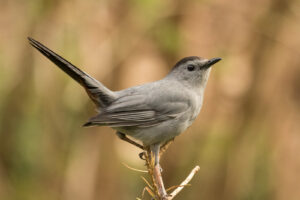
Range in Iowa: Gray Catbirds are summer residents throughout Iowa.
Identification:
Size: About the length of a Red-winged Blackbird or Northern Cardinal.
Shape: Long tailed, round head.
Bill: Medium-length, pointed.
Color: Gray with a black tail and black cap. Rusty under tail coverts.
Habitat, range & behavior: Dense woodland edges, scrub, abandoned orchards.
Breeds in eastern and central US and adjoining southern Canada. Winters in extreme south US Gulf states, southward in eastern Mexico to Panama.
They spend much time hopping on the ground or in low bushes. They defend a winter territory, unlike most birds.
Food and feeder preference: Insects and berries. You may attract this species with jelly and fruit feeders, suet, and water.
18. House Wren (Troglodytes aedon)
These birds will readily use nest boxes to raise their young.
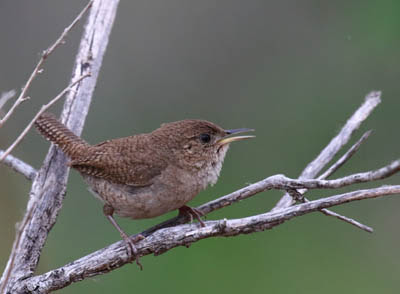 |
| House Wren. Greg Gillson. |
Range in Iowa: House Wrens are summer residents throughout Iowa.
Identification:
Size: About the size of Black-capped Chickadee but with shorter tail.
Shape: Round body. Large head. Thin short tail.
Bill: Fairly long, thin, slightly down curved. Sharply pointed.
Color: Rather dull brownish-gray throughout. Paler throat and breast. Tail barred with black and pale bars along with the brown.
Habitat, range & behavior: Brushy areas, woodland edges, hedge rows, tree stumps in logged areas.
Breed across Canada and the northern and mid-latitudes of the United States. Winter to the southern United States and through Mexico. Found year round at southern edge of breeding range: California, North Carolina to northern Alabama, southern Arizona south through mountains of Mexico.
Stay hidden in brushy areas. Hop among tree roots, logged stumps.
Food and feeder preference: May feed at suet feeder.
19. Common Grackle (Quiscalus quiscula)
Sometimes considered a pest to crops, grackles are longer and lankier than very similar blackbirds.
 |
| Common Grackle. GeorgiaLens from Pixabay |
Range in Iowa: Common Grackles are year-round residents throughout Iowa.
Identification:
Size: Larger than Red-winged Blackbirds, they are near the length of Mourning Doves.
Shape: Long, with long full keel-shaped tail, long legs, flat crown.
Bill: Longer than head, pointed, but stouter than other blackbirds.
Color: Glossy black with hint of bronze or green on head (depending upon population). Yellow eye.
Habitat, range & behavior: They are found in agricultural areas, woodland edges, city parks and lawns.
Resident in the southeastern United States. In summer they migrate northward and west to the central United States and Canada.
They monopolize feeders and are bullies toward other birds.
Food and feeder preference: Grain, corn, acorns, small aquatic fish and amphibians. To discourage them, use tube feeders, rather than hopper or tray feeders. Don’t over-feed, keep spilled seed picked up.
20. Northern Flicker (Colaptes auratus)
Of all the bird identification questions I get asked, this common larger backyard bird is the bird most people ask about. It doesn’t occur to those unfamiliar with it that this could be a woodpecker.
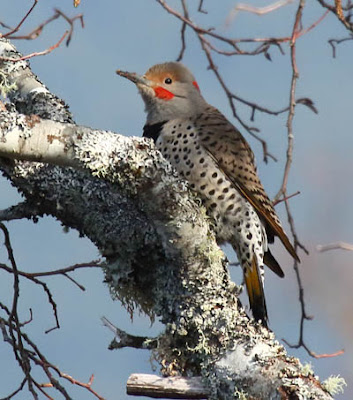 |
| Northern Flicker. Greg Gillson. |
Range in Iowa: Northern Flickers are year-round residents throughout Iowa.
Identification:
Size: About the size of a Mourning Dove. Larger than a robin.
Shape: Stocky with short legs, short tail, big head.
Bill: As long as head, thin, slightly curved.
Color: Back is brown with black bars. Under parts pinkish with black spots. Undersides of black wing and tail feathers are bright salmon red (West) or yellow (East). Head gray (West) or brown (East) and males with red (West) or black (East) whisker marks and nape marks (East). Black crescent across chest. White rump seen in flight.
Habitat, range & behavior: Found in woodland edges and forests.
Year-round resident from extreme southern Canada, across all of the lower-48 states and in the mountains of Mexico and Middle America. In summer breeds northward well into Canada and Alaska.
Frequently noted hopping on ground pecking in the ground for insects. In late spring, males proclaim their territory by rapid pounding on a hollow tree branch, though the ringing of metal downspouts at dawn is louder and carries much farther, to the exasperation of anyone trying to sleep inside!
Food and feeder preference: Ants and beetles are their primary foods. Will eat black oil sunflower seeds and are attracted to suet.
21. Barn Swallow (Hirundo rustica)
These swallows are widely distributed throughout the world, primarily breeding in the northern hemisphere, and wintering in the mid-latitudes and southern hemisphere.
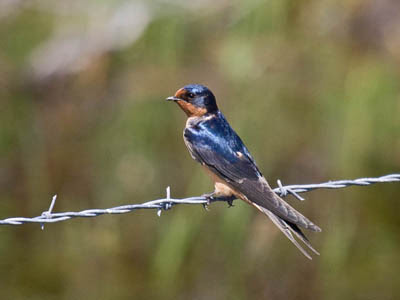 |
| Barn Swallow. Greg Gillson. |
Range in Iowa: Barn Swallows are summer residents throughout Iowa.
Identification:
Size: About the size of a House Finch but with a much longer tail.
Shape: Stocky, short necked but with long body and tail. Tail is forked, with very long outer tail feathers. Wings pointed.
Bill: Short, wide.
Color: Glossy dark purplish-blue above. Pinkish-orange below.
Habitat, range & behavior: Barn Swallows live in open country, frequently near humans. Farmlands. Nest in barns, under small bridges.
In North America breed from Mexico to northern Canada and Alaska, wintering from southern Mexico throughout most of South America.
Frequently seen swooping low over the ground hunting flying insects. Perch on wires, fences. Voice is twitters and chirps with grating sounds.
Food and feeder preference: Eat flying insects on the wing and are not attracted to backyard feeders.
22. Indigo Bunting (Passerina cyanea)
Don’t mistake Indigo Buntings for the larger Blue Grosbeak. As the name suggests, the grosbeak has a much larger and thicker bill, along with rusty wing bars, lacking in Indigo Buntings.
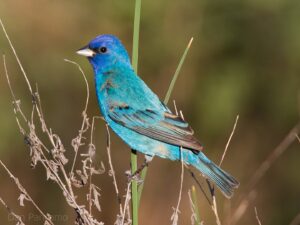
Range in Iowa: Indigo Buntins are summer residents throughout Iowa.
Identification:
Size: These birds are a bit smaller than a House Sparrow.
Shape: Plump. Large round head. Medium short tail.
Bill: Large and conical.
Color: Males are deep blue. Females are pale gray-brown with diffuse streaks below.
Habitat, range & behavior: Open woodlands and clearings. Country farm roads.
They are found in the East and parts of the Southwest, north to southern Canada.
Sing from the tallest tip of tree or telephone lines, a cheerful paired bouncy song very similar to American Goldfinch. In fact, they are sometimes called “blue goldfinches” because of this!
Food and feeder preference: These birds will eat seeds from hopper feeders, perhaps more so in the late spring when they first arrive during migration.
23. Brown-headed Cowbird (Molothrus ater)
Cowbirds are small blackbirds lay their eggs in the nests of other smaller birds, such as warblers. The adoptive parents raise their young!
 |
| Brown-headed Cowbird. Greg Gillson. |
Range in Iowa: Brown-headed Cowbirds are summer residents throughout Iowa.
Identification:
Size: Larger than White-crowned Sparrows, but smaller than Rose-breasted or Black-headed Grosbeaks. Smaller than other blackbirds, starlings, and grackles.
Shape: Perhaps a little bit pot-bellied. Medium length tail. Flat forehead as typical for blackbirds.
Bill: Rather thick and stout.
Color: Males are glossy black with rich brown head. Females are dusty gray-brown throughout. Long-held juvenile plumage similar to pale female, scaly, being fed by Yellow Warbler or Song Sparrow or a hundred other host species.
Habitat, range & behavior: They are found in woodlands and farms. Also with other blackbirds in winter at shopping center parking lots.
In summer they breed across Canada and most of the United States and Mexico. In winter they move south out of Canada and occupy both coasts and southeastern States in the US.
These small blackbirds join other flocks of blackbirds in cattle feedlots. You may see cowbirds riding on the backs of cattle, sheep, or horses. They originally rode on the backs of American bison on the Great Plains but expanded when forests were cut.
Food and feeder preference: Cowbirds eat grains, seeds, and insects. They will readily come to hopper and platform feeders. They are larger and more aggressive, so keep other birds from feeders and have a big appetite!
24. Chipping Sparrow (Spizella passerina)
Chipping Sparrows are a widespread species adapted to human disturbance. They are rather tame. They are frequently found in cemeteries with large trees.
 |
| Chipping Sparrow. Greg Gillson. |
Range in Iowa: Chipping Sparrows are summer residents throughout Iowa.
Identification:
Size: These are small sparrows, bigger than goldfinches or chickadees, but smaller than House Finches or Song Sparrows.
Shape: Plump and fairly long tailed.
Bill: Short and conical.
Color: Striped brown and dark brown above. Grayish under parts. Black line through eye. Crown streaked in winter but in summer becomes solid chestnut. Two white wing bars.
Habitat, range & behavior: Grassy open conifer woodlands with some shrubs, parks, orchards.
Breeds from Alaska, across Canada and south into highlands of Middle America. In winter retreats from northern areas to southern United States and northern Mexico.
In summer solitary or in pairs. In winter they forage in flocks of up to 50 birds.
Food and feeder preference: Weed seeds, supplemented with insects in summer. They may eat black oil sunflower seeds in your feeder, but more likely will feed on mixed seeds on the ground under the feeder.
25. Eastern Kingbird (Tyrannus tyrannus)
These birds often build nests in trees that overhang streams.
 |
| Eastern Kingbird. Greg Gillson. |
Range in Iowa: Eastern Kingbirds are summer residents throughout Iowa.
Identification:
Size: About the size of a Red-winged Blackbird. Smaller than a robin.
Shape: Fairly sleek. Perches upright with big puffy head, full tail.
Bill: Fairly long, wide at base,
Color: Black head. Black tail with white band at tip. Dark gray upper parts. White under parts.
Habitat, range & behavior: Farms, clearings in woodlands.
Found across Canada and in the United States east from the Rocky Mountains.
These birds perch on fence lines, tips of small trees. Sally out and snatch flying insects and return to perch.
Food and feeder preference: They eat insects and do not come to feeders.
26. Baltimore Oriole (Icterus galbula)
These are beautiful summer songbirds in the East.
 |
| Baltimore Oriole. Michael McGough from Pixabay. |
Range in Iowa: Baltimore Orioles are summer residents throughout Iowa.
Identification:
Size: Smaller than a robin; just a bit smaller than a Red-winged Blackbird.
Shape: Rounded belly. The body is long with long under tail coverts, but the tail is somewhat short. Large head.
Bill: Fairly long and heavy. Pointed, slightly curved.
Color: The males are brilliant orange below, black above, including a hood over the head. Wings are black with two wing bars. Females are yellowish orange below and more olive-green above, but still show the white wing bars.
Habitat, range & behavior: Shade trees and deciduous woodlands.
Found east of the Rocky Mountains from Canada southward. Winter in far southeastern coastal US and Florida, and southward.
Orioles build sock-like hanging nests made of long fibers. These nests often last the winter and may be observed once the leaves are off the trees.
Food and feeder preference: These birds eat insects, fruit, and nectar. You may be able to attract orioles to your feeders with cut oranges and special oriole nectar feeders similar to hummingbird feeders.
27. Eastern Wood-Pewee (Contopus virens)
Eastern Wood-Pewees and Western Wood-Pewees appear very similar. Their ranges nearly splits the continent in half, east and west. Their song separates them; it is a clear whistled pee-a-wee in the Eastern Wood-Pewee, and a burry pee-yeear in the Western Wood-Pewee.
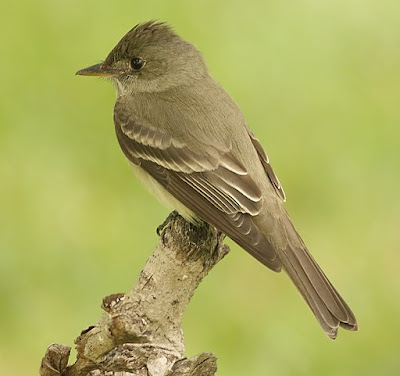 |
| Eastern Wood-Pewee. Tony Castro CC 4.0 |
Range in Iowa: Eastern Wood-Pewees are summer residents throughout Iowa.
Identification:
Size: Bigger than a House Finch; smaller than a bluebird.
Shape: Upright posture. Large head. Thick chest. Long tail. Long wings.
Bill: Medium length, wide at base. Black above; yellow-orange below.
Color: Grayish-olive above, slight yellow tinge below (looks white in strong light). Pale wing bars. No eye ring.
Habitat, range & behavior: Woodlands. Large shade trees in town.
Summer resident in the East, from southern Canada southward.
These flycatchers tend to perch on a dead twig high in the canopy. They sing throughout the day, attracting attention to this otherwise quite drab and nondescript bird.
Food and feeder preference: These birds feed on flying insects and do not come to feeders.
Common Birds in Iowa
To determine how common each species is I used the data from actual bird sightings from the citizen science program eBird. Birds are listed by frequency. That is, how often the species is recorded on checklists submitted to eBird (a percentage).
When choosing the birds to include in this article I leaned strongly to birds that are present throughout the year in good numbers. Thus, many of the common birds are year-round residents. This means that they live in the same location all year. They raise their young in your neighborhood. They don’t migrate. Or if the species does migrate, the ones living in your area don’t. If this is the case, some migrants may move into your area during certain times of year, adding to the same species that are in your yard full time.
Some migrant birds visit your yard during the “summer.” Often, they arrive in spring and remain until late fall. They nest and raise their young in your neighborhood. These are the summer residents.
Other migrant birds visit your backyard during the “winter.” Some of these winter visitors may arrive in July and remain into April. Others may only be found in the cold of December or January. They key here is that they nest and raise their young somewhere else. They only visit your yard in the non-breeding season.
Migration is an amazing spectacle.
There will be birds that fly through your region in spring or fall (or both). They may visit your backyard only a few days or weeks a year. They aren’t regular enough, or stay long enough, to be included in this article. But the number of briefly visiting migrant birds could double the number of species presented here. You may see them over time. Consult checklists in eBird for your county to see what is possible.
I have generally excluded common waterfowl, birds of prey, shorebirds, seabirds, and others that aren’t usually found in residential areas. But they may certainly fly over or be seen regularly if your home is on a shoreline, for instance.
Most common backyard birds in Iowa throughout the year
The following list is the backyard birds that are, on average, most common throughout the entire year. The list is ordered by most common based on the frequency of how often each species is recorded on checklists submitted to eBird.
- Northern Cardinal (49% frequency)
- American Robin (43%)
- Black-capped Chickadee (41%)
- Blue Jay (39%)
- Downy Woodpecker (37%)
- American Crow (35%)
- American Goldfinch (34%)
- Red-bellied Woodpecker (34%)
- Red-winged Blackbird (33%)
- White-breasted Nuthatch (32%)
- House Sparrow (32%)
- Mourning Dove (30%)
- European Starling (27%)
- Dark-eyed Junco (24%)
- Song Sparrow (21%)
- House Finch (19%)
- Gray Catbird (18%)
- House Wren (18%)
- Common Grackle (17%)
- Northern Flicker (16%)
Most common backyard birds in Iowa in winter
- Dark-eyed Junco (49% frequency)
- Black-capped Chickadee (46%)
- Northern Cardinal (45%)
- Downy Woodpecker (44%)
- White-breasted Nuthatch (37%)
- American Crow (36%)
- Red-bellied Woodpecker (36%)
- House Sparrow (35%)
- Blue Jay (34%)
- European Starling (26%)
- American Goldfinch (24%)
- House Finch (23%)
Most common backyard birds in Iowa in summer
- American Robin (67% frequency)
- Red-winged Blackbird (60%)
- Northern Cardinal (52%)
- Mourning Dove (50%)
- House Wren (49%)
- American Goldfinch (46%)
- Gray Catbird (46%)
- House Sparrow (38%)
- Barn Swallow (36%)
- Indigo Bunting (36%)
- Blue Jay (36%)
- Song Sparrow (33%)
- Brown-headed Cowbird (33%)
- Common Grackle (32%)
- Chipping Sparrow (30%)
- Black-capped Chickadee (30%)
- Eastern Kingbird (29%)
- Downy Woodpecker (29%)
- American Crow (28%)
- Baltimore Oriole (28%)
- European Starling (28%)
- Eastern Wood-Pewee (27%)
- Red-bellied Woodpecker (26%)
- White-breasted Nuthatch (25%)
How do birds differ between winter and summer?
Dark-eyed Juncos, Black-capped Chickadees, Downy Woodpeckers, White-breasted Nuthatches are more common in winter.
American Robins, Mourning Doves, House Wrens, American Goldfinches, Gray Catbirds, Barn Swallows, Indigo Buntings, Song Sparrows, Common Grackles, Brown-headed Cowbirds, Chipping Sparrows, Eastern Kingbirds, Baltimore Orioles, Eastern Wood-Pewees are more common in summer.
Common Backyard Birds of Des Moines, Iowa
 |
| American Robin. Greg Gillson |
- American Robin (49% frequency)
- Northern Cardinal (48%)
- Black-capped Chickadee (43%)
- Blue Jay (39%)
- Downy Woodpecker (36%)
- Red-bellied Woodpecker (34%)
- American Goldfinch (34%)
- European Starling (34%)
- White-breasted Nuthatch (33%)
- American Crow (31%)
- House Sparrow (25%)
- Mourning Dove (25%)
- Dark-eyed Junco (21%)
- Song Sparrow (20%)
- House Finch (20%)
The birds in Des Moines are representative and equally common as the birds in the state of Iowa as a whole.
Common Backyard Birds of Sioux City, Iowa
- American Robin (36% frequency)
- Red-winged Blackbird (33%)
- Black-capped Chickadee (30%)
- White-breasted Nuthatch (30%)
- Downy Woodpecker (29%)
- Northern Cardinal (29%)
- Red-bellied Woodpecker (28%)
- European Starling (25%)
- American Goldfinch (23%)
- Common Grackle (22%)
- Mourning Dove (21%)
- Blue Jay (21%)
- American Crow (21%)
Black-capped Chickadees, Downy Woodpeckers, Northern Cardinals, American Goldfinches, Mourning Doves, Blue Jays, American Crows, House Sparrows are less common in Sioux City than the state average, as a whole.
Many Midwest birds reach the northwestern limit of their year-round range in this area or nearby states, so are less common in Sioux City than elsewhere in Iowa.
Wrapping Up
Iowa has some interesting backyard birds but if you venture outside of your home, you can also find many other cool species around the state.
Open Fields and Meadows:
- Mourning Dove: Brownish-gray bird with a long, pointed tail. Soft, mournful cooing call. Found in fields and open woodlands.
- Eastern Meadowlark: Yellow-breasted bird with black V-shaped markings on its chest. Sings a clear, flute-like song. Seen in meadows and grasslands.
- Red-winged Blackbird: Blackbird with bright red epaulets on its shoulders. Males have a loud “konk-la-ree” call. Common in marshes and grasslands.
Forests and Woodlands:
- American Crow: Large black bird with a harsh “caw” call. Often seen in groups. Found in a variety of habitats.
- White-breasted Nuthatch: Small gray bird with a black cap and a white patch on its breast. Climbs down tree trunks headfirst. Taps on trees to find food.
- Eastern Wood-Pewee: Small brown flycatcher with a high, thin “pee-wee” call. Seen in open woodlands.
Frequently Asked Questions
What is the state bird of Iowa?
The state bird of Iowa is the American Goldfinch! This vibrant yellow songbird with a black cap and wings adds a cheerful touch to the state’s landscapes. It was chosen as the official state bird in 1933 due to its common occurrence throughout Iowa and its habit of staying through the winter. You’ll often see them in flocks feeding on thistle and other seeds, bringing a burst of color to fields and meadows.
What bird has a yellow belly in Iowa?
The Yellow Warbler has a bright yellow belly and can be seen in various environments in Iowa.
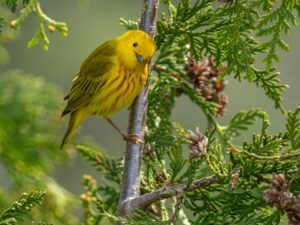
Wetlands and Waterways:
- Riparian areas: These are the lush, vegetated areas along streams, rivers, and lakes. Yellow Warblers often nest in the willows, alders, and other shrubs that grow along these waterways.
- Marshes and swamps: These wetlands provide dense vegetation and abundant insect life, which attract Yellow Warblers. Look for them in cattails, reeds, and other emergent plants.
Woodlands and Thickets:
- Willow groves: Willows are a favorite nesting habitat for Yellow Warblers, so look for areas with dense willow thickets.
- Second-growth forests: These forests, which have regrown after logging or other disturbances, often have a mix of young trees and shrubs that provide ideal habitat for Yellow Warblers.
- Forest edges: The transition zone between forests and open fields can also be good places to find Yellow Warblers.
Specific Locations in Iowa:
- Hickory Hill Park in Iowa City: This park is known for its dense forest and shrub habitat, making it a warbler hotspot during spring migration.
- Neal Smith National Wildlife Refuge: This refuge contains a variety of habitats, including wetlands, grasslands, and woodlands, making it a great place to see a diversity of birds, including Yellow Warblers.
- Yellow River State Forest: This forest offers extensive riparian areas and mature woodlands, providing ample habitat for Yellow Warblers.
What is the invasive bird in Iowa?
The House Sparrow is considered an invasive species in Iowa. It was introduced to North America from Europe in the mid-1800s and has since spread throughout the continent, including Iowa.
There are several reasons why the House Sparrow is considered invasive in Iowa:
- It is a very aggressive bird that can outcompete native birds for food and nesting sites. House Sparrows are known for displacing other birds from their nests and taking over the nests for their own use.
- They can carry and transmit diseases to other birds and to humans. House Sparrows have been linked to the spread of West Nile virus and other diseases.
- They can cause damage to property. House Sparrows can build nests in buildings and other structures, which can cause damage to the property.
The Iowa Department of Natural Resources considers the House Sparrow to be a nuisance bird and does not protect them under state law. This means that it is legal to control House Sparrows in Iowa, including killing them.
However, it is important to note that there are some ethical considerations involved in controlling invasive species. Some people believe that it is cruel or unnecessary to kill invasive species, even if they are causing harm to the environment. Others believe that it is necessary to control invasive species in order to protect native species and ecosystems.
Ultimately, the decision of whether or not to control invasive species is a complex one that should be made on a case-by-case basis. If you are concerned about the impact of House Sparrows on your property or the environment, you should consult with a wildlife expert to get advice on how to control them.
________________________________________________________________________________________________
Related Articles:
Red, Orange, & Yellow Birds of Iowa
34 of the most common birds in the United States (with photos)







